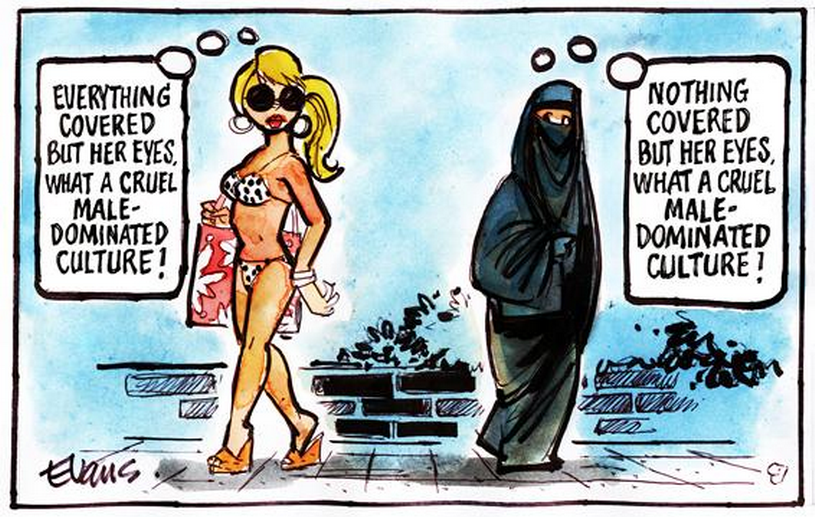Content Menu
● Introduction
● Cultural Symbolism in Cartoons
● Swimwear Design Strategies for OEM Factories
● Case Studies: Brands Bridging the Divide
● Media's Role in Shaping Demand
● Addressing Cultural Sensitivities
● Future Trends and Opportunities
● Frequently Asked Questions
>> Q1: Why do cartoons use the burka vs bikini contrast?
>> Q2: How can OEM factories address cultural sensitivities?
>> Q3: Is the burka always a symbol of oppression?
>> Q4: What trends are shaping swimwear demand?
>> Q5: How do cartoons influence consumer behavior?
>> Q6: How do cartoons influence swimwear trends?
>> Q7: Can OEM factories produce small batches of custom designs?
>> Q8: What fabrics work best for dual-purpose swimwear?
● Citations:
Introduction
The "burka vs bikini" dichotomy in cartoons has become a cultural flashpoint, revealing tensions between modesty, freedom, and patriarchal norms. For swimwear manufacturers, these debates underscore the need for adaptable designs that resonate with diverse markets. This article integrates cultural analysis with industry insights, exploring how OEM factories can leverage these narratives to meet global demand.

Cultural Symbolism in Cartoons
1. Satirical Commentary on Patriarchal Norms
The 2007 *Opus* comic strip exemplifies how cartoons critique gendered control over women's attire. When Lola Granola rejects her boyfriend's demand to wear a “steamy polka-dot bikini” in favor of a burkini, the strip challenges both Western hypersexualization and assumptions about Muslim women's oppression[1][5]. Similarly, Nawak's 2016 cartoon defending burkinis against French bans frames the issue as male-dominated institutions dictating women's choices[1].
2. Dual Perspectives on Liberation
A 2011 New Zealand cartoon juxtaposes a bikini-clad woman and a burqa-wearer, each condemning the other's attire as emblematic of patriarchal control[3]. This mirrors real-world debates:
- Bikinis symbolize body positivity but face criticism for perpetuating unrealistic beauty standards.
- Burqas are often misrepresented as inherently oppressive, despite many wearers citing religious agency[2].
3. Subversive Representations
*Burka Avenger*, a Pakistani cartoon, reimagines the burka as a superhero costume, empowering its protagonist to fight injustice while maintaining modesty—a direct counter-narrative to Western stereotypes[1].
Swimwear Design Strategies for OEM Factories
1. Market-Specific Adaptations
- Western Markets: Focus on bikini variants with inclusive sizing (e.g., high-waisted bottoms, tankini tops) and sustainable fabrics like recycled nylon[2].
- Conservative Regions: Offer burkini-inspired designs with breathable, quick-dry fabrics and customizable coverage (e.g., detachable hoods, adjustable hems)[4].
- Hybrid Trends: Develop reversible swimsuits that transition from bikini to modest styles, catering to travelers and multicultural consumers.
2. Ethical Production Practices
As a responsible OEM provider:
- Use OEKO-TEX® certified dyes to ensure skin safety.
- Implement zero-waste cutting techniques to minimize textile waste.
- Partner with Fair Trade-certified factories to guarantee ethical labor practices[2].
3. Technology-Driven Customization
- 3D Body Scanning: Enable clients to create tailored modest swimwear for diverse body types.
- Modular Design Software: Allow brands to mix-and-match components (e.g., sleeves, leggings) digitally before production.

Case Studies: Brands Bridging the Divide
| Brand | Innovation | Target Market |
| Nike Pro Hijab | Moisture-wicking hijabs for athletes | Muslim athletes |
| Dolce & Gabbana | Luxe lace burkinis | High-end modest fashion |
| Speedo Ultra | UV-protective full-body suits | Conservative markets |
Media's Role in Shaping Demand
1. Cartoons as Cultural Barometers
Mainstream media often reduces the "burka vs bikini" debate to simplistic binaries, but alternative platforms like blogs and indie cartoons provide nuanced takes. For instance, feminist blogs champion the burkini as a tool to evade the male gaze, while satirical strips critique both extremes[1][5].
2. Viral Moments and Market Shifts
France's 2016 burkini ban paradoxically boosted global sales by 200%, with non-Muslim buyers (e.g., skin cancer survivors) comprising 40% of new customers[4]. OEM factories must anticipate such demand spikes through agile production scaling.
Addressing Cultural Sensitivities
1. Regional Compliance
- EU Markets: Adhere to bans in specific French municipalities by offering “sportswear-inspired” alternatives that meet legal criteria.
- Middle East/North Africa: Collaborate with local designers to incorporate traditional embroidery or abaya-inspired silhouettes.
2. Inclusive Marketing
- Feature diverse models in campaigns, including hijabi athletes and plus-size bikini wearers.
- Avoid exoticizing modest swimwear; instead, normalize it as a functional choice.
Future Trends and Opportunities
1. Smart Fabrics
- Develop burkini/bikini hybrids with temperature-regulating textiles for extreme climates.
- Integrate RFID-blocking materials for privacy-conscious consumers.
2. AI-Driven Design
Use machine learning to analyze regional search trends (e.g., “burkini cartoon” spikes) and predict style preferences.
Frequently Asked Questions
Q1: Why do cartoons use the burka vs bikini contrast?
A1: To critique patriarchal control over women's bodies, whether through hypersexualization or enforced modesty[1][5][7].
Q2: How can OEM factories address cultural sensitivities?
A2: Offer customizable designs—e.g., reversible swimsuits or modular coverage options—to cater to diverse markets.
Q3: Is the burka always a symbol of oppression?
A3: No. Many women choose it for religious devotion or personal comfort, though forced usage remains a concern[3][7].
Q4: What trends are shaping swimwear demand?
A4: Sustainability, inclusivity, and adaptive designs (e.g., UV-protective fabrics, maternity-friendly cuts).
Q5: How do cartoons influence consumer behavior?
A5: Media representations shape perceptions; brands aligned with progressive values (e.g., body diversity) gain loyalty.
Q6: How do cartoons influence swimwear trends?
A6: Viral comics like *Opus* shape public perceptions, prompting brands to address cultural debates through inclusive designs[1][5].
Q7: Can OEM factories produce small batches of custom designs?
A7: Yes, modular production systems allow cost-effective small runs—ideal for testing burkini-bikini fusion styles.
Q8: What fabrics work best for dual-purpose swimwear?
A8: Chlorine-resistant polyester-spandex blends offer durability for both bikinis and burkinis.
Citations:
[1] https://escholarship.org/content/qt9d0860x7/qt9d0860x7.pdf?t=lnqx4d
[2] https://www.abelyfashion.com/burka-vs-bikini-decoding-freedom-modesty-and-choice-in-swimwear.html
[3] https://www.open.edu/openlearn/history-the-arts/veiling/content-section-2.1
[4] https://en.wikipedia.org/wiki/Burkini
[5] https://escholarship.org/content/qt9d0860x7/qt9d0860x7_noSplash_cc49a793f790e331f7611f417e551832.pdf?t=lnqx4d
[6] https://www.reddit.com/r/Feminism/comments/b8jke5/this_cartoon_was_posted_as_an_attempt_to_accept/
[7] https://www.cartoonstock.com/directory/b/burqa.asp
[8] https://www.cram.com/essay/The-Burka-And-The-Bikini-Analysis/FKG77ZSYHBWQ
[9] https://thesocietypages.org/socimages/2012/02/22/questioning-definitions-of-freedom/
[10] https://www.cartoonstock.com/directory/s/swimsuit_controversy.asp
[11] https://archive.blogs.harvard.edu/reneemotley/2014/05/07/oppression-or-freedom/
[12] https://www.open.edu/openlearn/history-the-arts/veiling/content-section-4/?printable=1
[13] https://www.iamhiphopmagazine.com/hijab-vs-bikini-understanding-cultures-ideologies/
[14] https://www.cartoonstock.com/directory/b/burqa_controversy.asp
[15] https://forward.com/life/150090/why-i-cover-up/
[16] https://istizada.com/muslim-veil-and-hijab-types-a-complete-guide/
[17] https://natlib.govt.nz/records/22728118
[18] https://www.democraticunderground.com/10026022609

































































